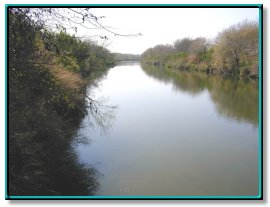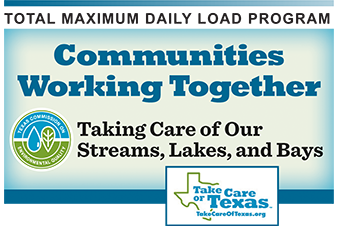Oso Creek: Recreational Uses
County: Nueces
Parameter: Bacteria
Coastal Basins: Bays and Estuaries, Nueces–Rio Grande Coastal Basin
Segment: 2485A
Assessment Unit (AU): 2485A_01
On this page:
- Overview and Goal
- Watershed Description
- Approved I-Plan
- Adopted TMDL
- Reports
- Contact the TMDL Program
Overview and Goals
Since 2002, water quality testing has found that concentrations of bacteria are elevated in Oso Creek, which may pose a risk to people who swim or wade in it. Swimming and wading are called “contact recreation” in the state’s standards for water quality; the term refers to all recreation in which people come in direct contact with the water. The goal of this project is to reduce bacteria concentrations to within acceptable risk levels for contact recreation.
In response to these conditions, TCEQ developed a TMDL for Oso Creek. The goal of a TMDL is to determine the amount (or load) of a pollutant that a body of water can receive and still support its beneficial uses. The allowable load is then allocated among categories of sources within the watershed.
Since 2003, TCEQ, the Texas State Soil and Water Conservation Board, and other agencies have conducted several studies of bacteria sources and quantities in the Oso Creek watershed. In 2013, based on results of those studies, TCEQ began developing a TMDL for the creek. The Texas Institute for Applied Environmental Research completed technical tasks in support of TMDL development.
The TCEQ and area stakeholders also assessed the oyster waters use of Oso Bay and have completed a TMDL for bacteria in Oso Bay. The work done to improve Oso Creek should also improve conditions in Oso Bay.
Watershed Description
The Oso Creek watershed is wholly contained within Nueces County in the Nueces-Rio Grande Coastal Basin. The creek is about 28 miles long. It flows southeasterly from near the western edge of Corpus Christi over flat to rolling terrain, emptying into Oso Bay. Oso Creek’s flow is dominated by regulated discharges.
Corpus Christi is the only major metropolitan area within the watershed’s boundaries. Robstown is about 3 miles northeast of the creek’s origin. Economic activities in the area include oil and gas refining and production, agriculture, manufacturing, and tourism.
Get Involved
Staff from the Center for Coastal Studies at Texas A&M University–Corpus Christi is working with stakeholders to develop a plan for watershed improvement. Public meetings about this project are open to everyone. Contact the TMDL Program to find out about ways you could be involved. The most recent I-Plan stakeholder meeting occurred on Aug. 27, 2025.
Approved I-Plan UPDATE
Community stakeholders worked together to create the I-Plan. The Commission approved the stakeholders' plan on Aug. 6, 2025.
- Corpus Christi Regional I-Plan
- Response public comment (two comments received)
Adopted TMDL
The commission adopted the TMDL on July 31, 2019. The EPA approved it on Oct. 25, 2019, at which time it became part of the state's Water Quality Management Plan (WQMP).
-
One TMDL for Indicator Bacteria in Oso Creek
Segment: 2485A; Assessment Unit: 2485A_01 - Response to Comment on the TMDL
Revisions to TMDLs
From time to time, it is necessary to revise TMDLs to account for changing conditions in the watershed. Revisions to the load allocations in TMDLs are made via the state’s Water Quality Management Plan (WQMP), which is updated quarterly.
The WQMP provides projected effluent limits for use in planning and permitting activities under the Texas Pollutant Discharge Elimination System (TPDES). The TCEQ reviews all applications for new and amended permits for conformance with applicable portions of the WQMP, including adopted TMDLs.
Updates
Updates are made to account for changing conditions in the watershed, such as new or revised wasteload allocations, permits that have been canceled or have expired, or changed facility names. Updates use the same units of measure as the original TMDL.
- July 2022, Appendix V, pages 27-28
- January 2020, Appendix VI, page 19
WQMP updates may be viewed in person at the TCEQ Library, Building A, 12100 Park 35 Circle, Austin, Texas. Electronic versions of updates published from 2014 through the present are available on the Texas State Library and Archives Commission website .
Reports
- 2016 Riparian Evaluation, Nueces River Authority
- Technical Support Document
Contact the TMDL Program
Please email tmdl@tceq.texas.gov and mention the Oso Creek Bacteria project in the subject line. Or call us at 512-239-6682.





 Back to top
Back to top